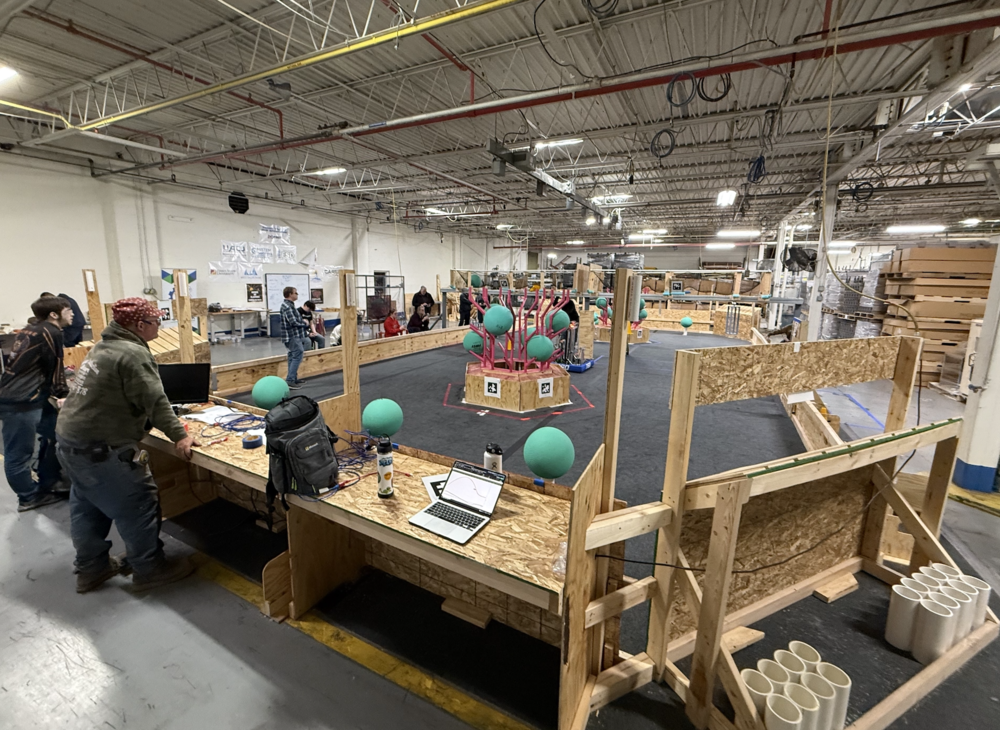Imagine a high school basketball team assembling themselves for tip-off in their season opener. The players look uneasy because the only place they have had to practice was much smaller than a regulation court with hoops four feet lower.
“No one would say that basketball team was well-prepared for competition,” said Brian Dotson, MiSTEM director with the West Shore Educational Services District. “Yet, that’s the very position that our FIRST® robotics teams in our region have been in – until now.”
FIRST®, an acronym For Inspiration and Recognition of Science and Technology, is an international competition that introduces students to careers in science, technology, engineering and mathematics through an annual competition which challenges them to design, build, and program robots capable of offensive and defensive moves. Parameters for these cyber-athletes – and the field on which they compete – change annually.
The public is invited to join Brian, regional business partners, and local robotics teams and coaches representing area high schools on Tuesday, Sept. 30, at 3:15 p.m. for a grand opening celebration at the UACJ FIRST® Robotics Practice Facility. This 8,500 square foot warehouse is on loan from UACJ Automotive Whitehall Industries located at 801 S. Madison St. in Ludington.
Following brief opening remarks and a ribbon-cutting ceremony, attendees are invited to watch representatives from six area FIRST® teams compete with robots built for last winter’s engineering challenge in a three-on-three scrimmage. (Specifications for the next FIRST® challenge will be revealed Jan. 10, 2026.) Following the scrimmage, guests can linger for up-close-and-personal demonstrations of how to drive a robot.
The grand opening celebration is being held in conjunction with MiSTEM Network’s quarterly business meeting which Brian hosts in the Ludington area.
The MiSTEM Network, launched by the Michigan Department of Labor and Economic Opportunity, is a statewide group of about 60 educators and business leaders who work together to broaden interest in and access to careers in science, technology, engineering and mathematics, for which there is growing demand.
“Supporting the FIRST® Robotics programs by providing access to our warehouse space is a natural extension of our commitment to education, innovation, and community development,” said Mike Wegener, president of UACJ. “These students are the future of engineering and manufacturing, and we’re proud to play a small role in helping them grow their skills and confidence.”
The warehouse space was previously used for storage and light operations, but Mike said in making it available as a properly equipped practice space for area FIRST® teams “… we saw the opportunity to create something that truly benefits the next generation.”
Partially on the merits of what UACJ is doing for robotics students by providing 24-hour access to heated workspace with WiFi and bathrooms, the company is among three finalists for the Mason County Business Alliance’s Business of the Year.
Robotics teams from Ludington, Hart, Shelby, Mason County Eastern, and the charter school Gateway 2 Success in Scottville all used a temporary UACJ practice facility for the 2025 version of FIRST®.
In most cases, the FIRST® teams were building their robots in a classroom at school and had no opportunity to run it on a regulation size field until their initial tournament in late February.
The new practice facility will be practically perfect now, Brian said, because the community foundation provided a $28,000 grant to purchase a regulation FIRST® perimeter, which has been installed and will be taped and equipped according to specifications for each new design competition.
“Thank you, thank you, thank you!” one high school robotics student wrote on an anonymous survey of the 2025 FIRST® program “This is such a fantastic resource for teams like mine that can't afford to purchase 100% of game elements totally on our own.”
And the practice facility will undoubtably keep getting better, as Brian has already applied for a grant that would fund adding a workshop on site.
Having greater access to real-world tools would allow students to grow their skills by applying the method STEM workers use to improve products, which Dotson described as “engineer, test, fix, engineer, test, fix.”
Grant funding in also being sought to add dedicated space at the practice facility for middle school FIRST® programs.
WIth varying degrees of success, Brian has been working to secure a practice facility for area robotics teams for several years, and he acknowledges that as UACJ expands its own business, there may come a day UACJ may need to reclaim its former warehouse space.
“But as long as we have wonderful community partners like UACJ and so many others," said Brian, “our region's robotics teams will continue to successfully build, innovate, and compete."

